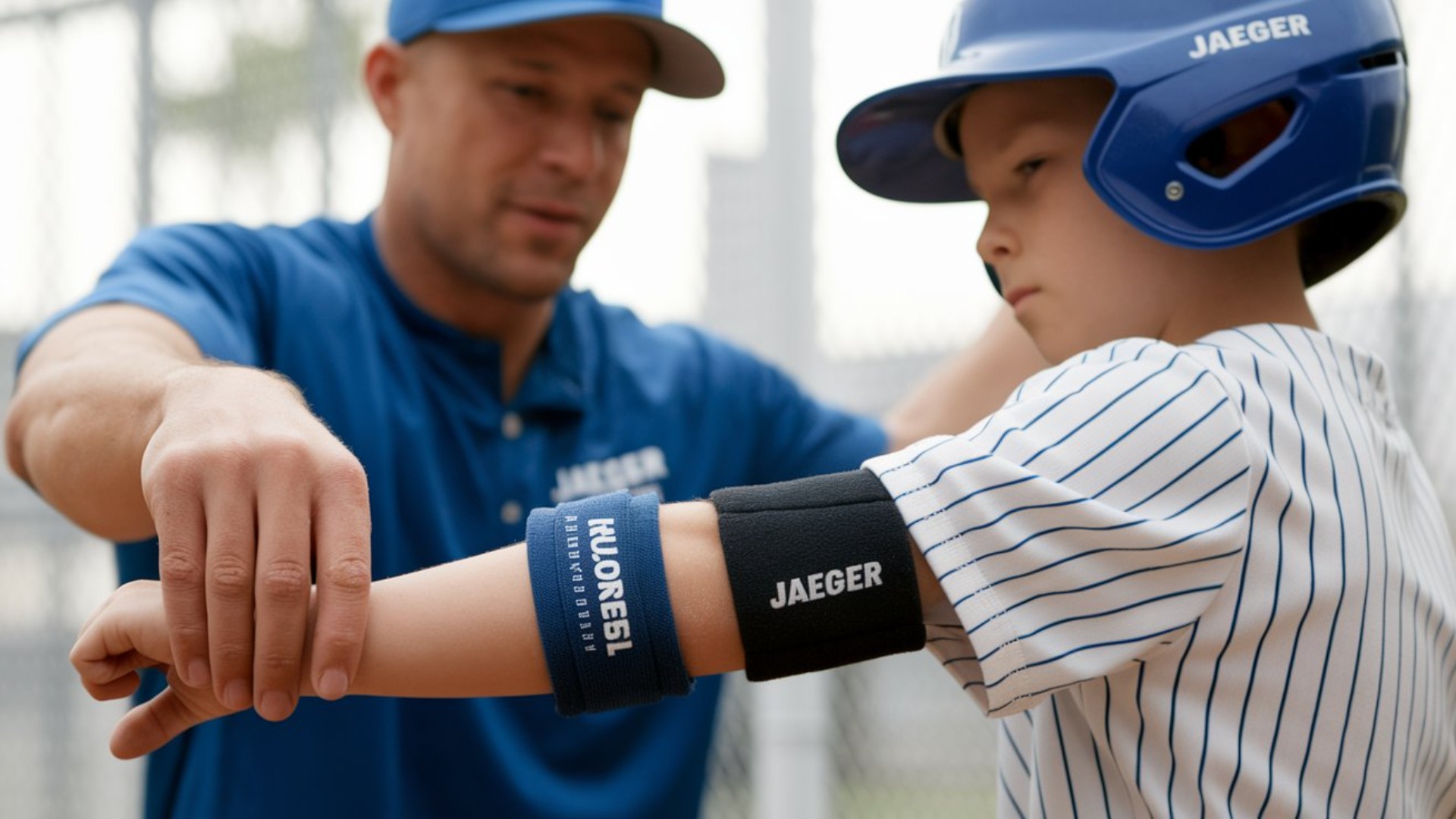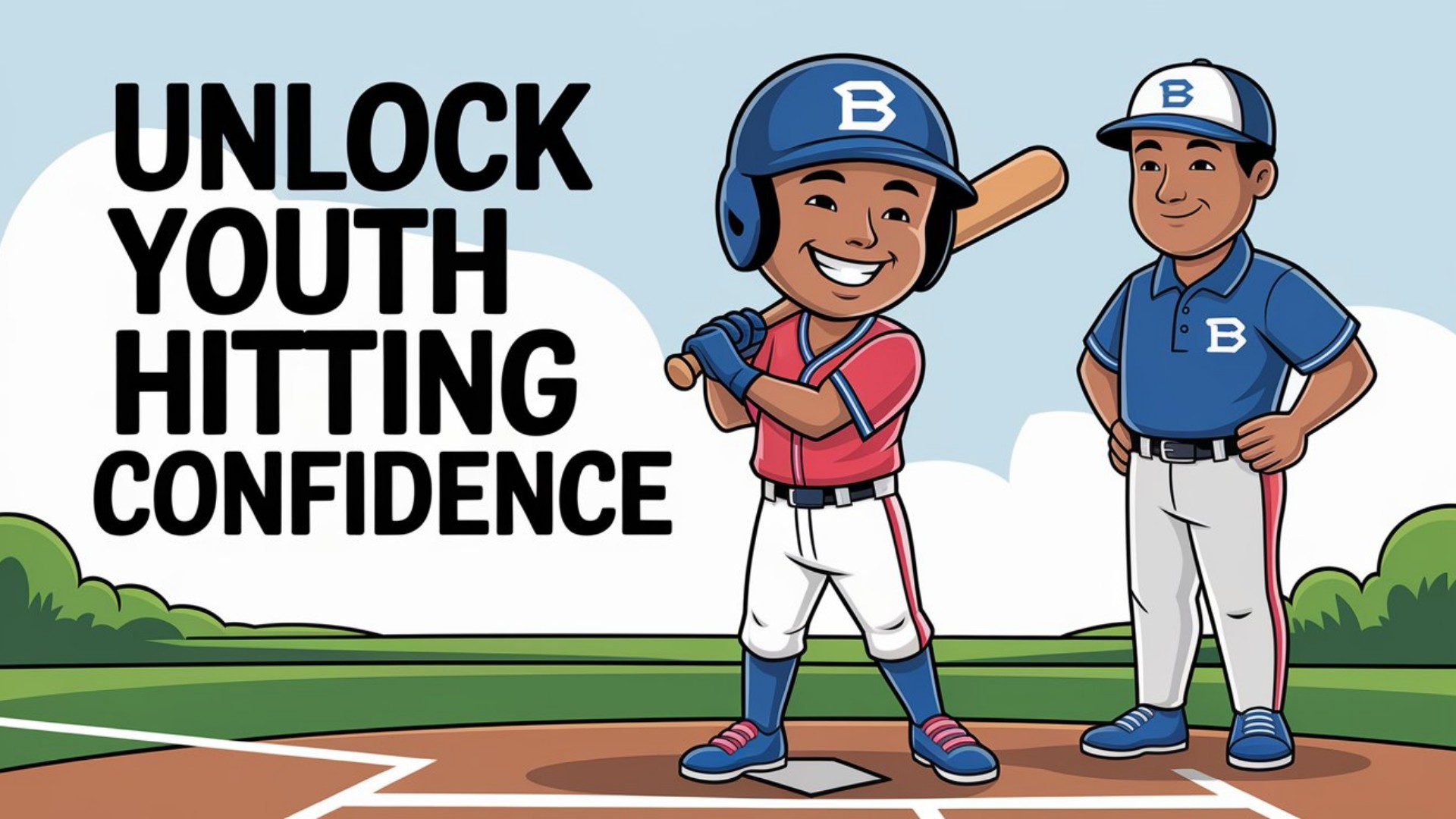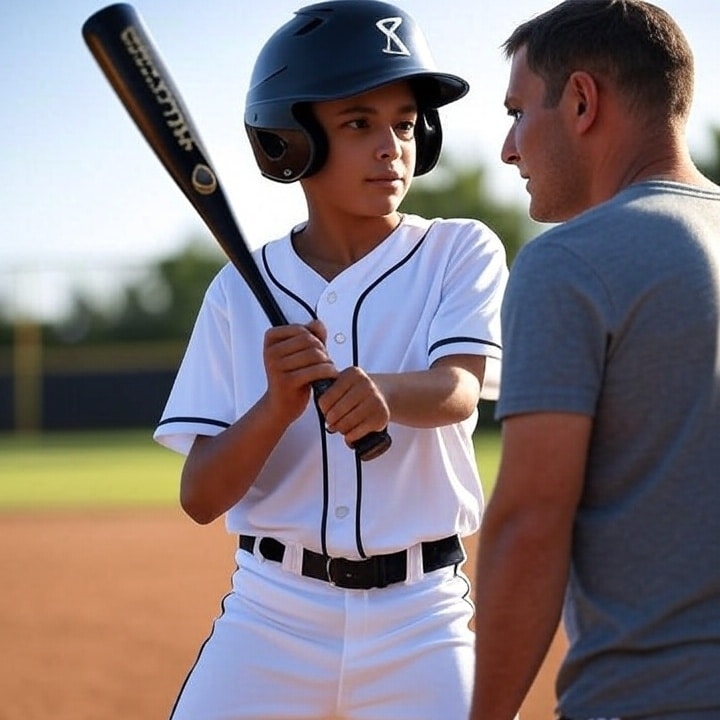
One Weird Between-Pitch Trick That Resets a Young Hitter’s Entire Mindset
Did you know that mental preparation can be the deciding factor between good young baseball players and great ones? When physical skills are similar, it’s the mental game that often makes all the difference! As someone who’s worked with hundreds of young athletes, I’ve seen firsthand how mental focus drills can dramatically transform their performance.
Renowned sports psychologists like Dr. Ken Ravizza have shown that even young players can develop mental routines that boost their confidence and performance at the plate. By incorporating these proven mental techniques into their training, young athletes can gain a competitive edge that lasts throughout their baseball careers.
Key Takeaways
- Mental preparation is crucial for young baseball players to excel.
- Proven mental routines can boost confidence and performance.
- Young athletes can develop mental skills to gain a competitive edge.
- Coaches can implement age-appropriate mental techniques with their teams.
- Mental training is backed by sports psychology research.
The Mental Game in Youth Baseball
The mental aspect of youth baseball is a crucial factor that can make or break a player’s performance on the field! While coaches often focus on the physical aspects of the game, the mental game is equally important for young players to succeed.
Let’s dive into why mental focus matters for young players and how it impacts their performance.
Why Mental Focus Matters for Young Players
Mental focus is essential for young players to perform at their best. Dr. Jim Afremow’s research in “The Champion’s Mind” reveals that mental skills are trainable from a young age, and the earlier players start, the more natural these skills become. Young players face unique mental challenges, such as fear of failure and difficulty maintaining focus, which directly impact their physical performance on the field.
Research shows that youth athletes who develop mental routines experience less performance anxiety and greater enjoyment of the sport. This is because mental clarity creates the foundation for consistent physical execution – when a young player’s mind is calm and focused, their body can perform the skills they’ve practiced.
The Connection Between Mental Clarity and Physical Performance
The connection between mental focus and physical performance is especially critical during high-pressure situations like at-bats with runners in scoring position. Mental skills development should be integrated into regular practice sessions, not treated as a separate or optional component of youth baseball training. We’ll explore how mental focus directly impacts key baseball skills like hitting timing, pitch recognition, and defensive readiness.
Here’s a summary of the key points:
| Mental Aspect |
Physical Performance |
Impact on Game |
| Mental clarity |
Consistent execution |
Better performance under pressure |
| Focus on the game |
Improved skills |
Less performance anxiety |
| Mental routines |
Better decision-making |
Greater enjoyment of the sport |
Understanding the Psychology of Youth Baseball Players
Understanding the psychology of youth baseball players is crucial for developing effective mental routines that boost their confidence and performance on the field! Youth baseball players are at a critical stage of development, both physically and mentally. The mental game of baseball is a critical component of their performance, and coaches and mentors need to be equipped with the right strategies to support these young athletes.
Dr. Michael Gervais, on his Finding Mastery Podcast, highlights how youth athletes process information differently at various developmental stages, emphasizing the need for coaches to adapt their mental training approaches. This is a key consideration when developing mental routines for young players.
Age-Appropriate Mental Approaches
Age-appropriate mental approaches are essential for youth baseball players. The cognitive development of players between 8-12 years old varies significantly, and mental training should be tailored accordingly. For example, 8U players benefit from simple, concrete routines, while 12U players can handle more abstract visualization techniques. This differentiation is crucial for effective mental training.
Let’s look at how different age groups can be supported with appropriate mental approaches:
| Age Group |
Mental Approach |
Examples |
| 8U |
Simple, Concrete Routines |
Basic visualization, positive self-talk |
| 10U |
Intro to Abstract Concepts |
Simple visualization exercises, introduction to mindfulness |
| 12U |
More Advanced Mental Techniques |
Advanced visualization, focus on emotional control |
Common Mental Challenges Young Players Face
Young baseball players face several mental challenges, including fear of making mistakes, difficulty handling failure, and struggling to stay present. These challenges can be significant obstacles to their performance and enjoyment of the game. Perfectionism is another common issue, which can be both a motivator and a barrier to success.
The social dynamics of youth baseball also create unique psychological pressures. Players often worry about disappointing teammates, coaches, and parents, adding to their mental burden. Understanding these challenges is key to developing effective mental routines that address these specific issues.
7 Essential Youth Baseball Focus Drills for Game-Day Confidence
Boosting game-day confidence in youth baseball requires more than just physical skills; it demands mental toughness and focus! As a coach or player, you’re about to discover the secret to enhancing your mental game and taking your performance to the next level.

Pre-Game Visualization Routine
The Pre-Game Visualization Routine is a powerful technique that teaches young players to mentally rehearse success before stepping onto the field. This method, popularized by Dr. Ken Ravizza, helps players visualize their success and build confidence. To implement this drill, have players find a quiet spot, close their eyes, and vividly imagine themselves performing well in the game. They should visualize the sights, sounds, and feelings of success, from hitting a home run to making a great catch.
The “Three Breath” Reset Technique
The “Three Breath” Reset Technique is a simple yet effective tool for regaining focus after distractions. This technique involves taking three deep breaths, inhaling through the nose and exhaling through the mouth, to calm the mind and refocus attention. It’s perfect for between pitches or after an error, helping players reset and stay focused on the present moment.
Positive Self-Talk Batting Ritual
Negative self-talk can be a significant obstacle for young hitters. The Positive Self-Talk Batting Ritual helps combat this by teaching players to replace negative internal dialogue with positive affirmations. For example, instead of saying “Don’t strike out,” players learn to say “See the ball, hit the ball.” This simple shift in mindset can greatly improve a player’s confidence and performance at the plate.
The Focus Point Method
The Focus Point Method involves directing a player’s attention to a specific external target, eliminating mental clutter and improving concentration during critical moments. By focusing on a specific point, such as the pitcher’s release point or the seams of the ball, players can stay present and focused, even under pressure.
Between-Pitch Refocusing Drill
The Between-Pitch Refocusing Drill is designed to help players develop the crucial skill of “resetting” between each pitch. As Dr. Jim Afremow emphasizes, this skill is essential for consistent performance. By practicing this drill, players learn to let go of the previous pitch and focus on the next one, staying present and composed under pressure.
Post-Error Recovery Routine
Mistakes are an inevitable part of baseball, but it’s how players respond to those mistakes that matters. The Post-Error Recovery Routine gives players a systematic approach to bouncing back quickly after errors, rather than dwelling on them. This drill helps players develop resilience and maintain their focus on the game.
The “One Pitch at a Time” Mindfulness Exercise
The “One Pitch at a Time” Mindfulness Exercise is a powerful tool for developing present-moment awareness. By focusing on the current pitch and letting go of past at-bats or worries about the game’s outcome, players can stay grounded and focused. This mindfulness exercise helps players cultivate a “one pitch at a time” mentality, leading to improved performance and reduced stress.
These 7 essential focus drills aren’t just theoretical concepts; they’re battle-tested techniques that have been used with hundreds of youth players to create immediate improvements in game performance. By incorporating these drills into regular practice sessions, coaches can help their players develop the mental toughness and focus needed to succeed in youth baseball.
Implementing Mental Routines During Practice
The real magic happens when you implement mental routines during practice, not just on game day! As Dr. Ken Ravizza emphasizes in his Heads-Up Baseball approach, integrating mental training directly into physical drills is crucial for developing well-rounded players.
To effectively implement mental routines, you need to integrate them with physical training. This means incorporating mental drills into your baseball practice sessions. For example, players can practice the “Three Breath” technique before each batting practice swing or use visualization before fielding drills. By doing so, you’re not just training their bodies; you’re also sharpening their minds.
Integrating Mental Drills with Physical Training
Integrating mental drills with physical training is about creating a seamless connection between the two. Here are some strategies to achieve this:
- Use the “Three Breath” technique before each batting practice swing to enhance focus.
- Implement visualization exercises before fielding drills to improve mental clarity.
- Incorporate positive self-talk into every drill to boost confidence.
By integrating mental and physical training, you’re helping your players develop a strong mental game that complements their physical skills.
Creating Pressure Situations in Practice
Creating pressure situations in practice is vital for testing your players’ mental routines. This can be achieved through:
- Competitive team drills that simulate game-like scenarios.
- Timed challenges that require players to perform under pressure.
- Simulated game situations with consequences, such as extra conditioning for the losing team.
By gradually increasing the pressure in your practices, you’ll help your players build confidence in their mental routines and prepare them for the intensity of actual games. Remember, the goal is to make mental training a fun and integral part of your baseball drills, enhancing your players’ overall skill development.
This is a video in the Swing Shift series…
Boost your hitting skills with Swing Shift’s science-backed practice system! This program is packed with features to improve hand path stability, timing, and power. Enjoy engaging drills for consistent progress and fun challenges to keep training exciting. Swing Shift is designed to help players succeed at every level.
The Swing Shift platform lets you focus on key mechanics like bat angle, balance, and hand path control. Dive into step-by-step video lessons that cover power, contact, and rhythm, breaking down the science behind a great swing. With personalized feedback and progress tracking, you can refine your technique and watch your results improve.
Whether you’re a youth athlete, high school player, or elite hitter, Swing Shift is trusted by families and coaches everywhere. Master core skills like bat control, weight transfer, and rotational power with drills designed for real game results. Start your journey to hitting greatness with Swing Shift!
Swing Shift’s practice system offers a wide range of tools to elevate your hitting:
- RNT-based drills for real-time correction
- Engaging challenges for competitive practice
- Personalized training goals and skill progression
- Exclusive videos on timing, power, and consistency
- Hands-on feedback to track and improve your swing mechanics
- Trusted by dedicated parents, players, and coaches
Reach your full potential with Swing Shift’s comprehensive practice system. Elevate your hitting with cutting-edge techniques and proven, science-based training.
Boost Your Child’s Hitting Confidence & Power—Fast!
Give your young hitter an edge at the plate with proven drills designed to build explosive power, consistency, and confidence. Get instant access to 4 expert-crafted hitting guides—free for a limited time!
Get Your FREE Hitting Guides Now
Building Mental Toughness for Clutch Situations
When it comes to clutch situations in baseball, mental toughness is the key differentiator between successful and struggling players! Building mental toughness isn’t about being “tough” – it’s about developing specific skills that allow players to perform under pressure. According to Dr. Jim Afremow, mental toughness is trainable at any age, but young players have a unique advantage in developing these skills early.
One of the critical aspects of mental toughness is resilience, particularly after experiencing strikeouts. Developing resilience starts with a proper perspective – helping players understand that failure is part of baseball. Even the best hitters fail 7 out of 10 times! Teaching players specific post-strikeout routines gives them a systematic way to process the experience and refocus for their next at-bat.
Developing Resilience After Strikeouts
To develop resilience, players need to learn how to “park” negative experiences, as Dr. Ken Ravizza suggests. This means mentally moving past failures quickly rather than carrying them into subsequent at-bats. By doing so, players can maintain a positive mindset and improve their overall performance.
One effective way to do this is by teaching players a post-strikeout routine that includes a brief moment of reflection, followed by a focused reset, and then a confident step back into the batter’s box. This routine helps players process their emotions and get back to the game with confidence.
Maintaining Focus During High-Pressure At-Bats
Maintaining focus during high-pressure at-bats requires pre-planned mental routines that players have practiced extensively in lower-pressure situations. The physical and mental components are inseparable – proper body positioning and stance create the foundation for mental clarity during high-pressure situations. By practicing these routines, players can develop the mental toughness needed to perform under pressure.
Visualization techniques are particularly effective for preparing young players for high-pressure situations before they encounter them in games. By visualizing themselves succeeding in clutch situations, players can build confidence and develop a strong mental game.
Coaching Strategies to Reinforce Mental Focus
As a coach, you play a crucial role in developing your players’ mental focus, and it’s time to explore the strategies that can make a real difference! Coaching strategies that reinforce mental focus can transform your team’s performance, but they require consistency and intentionality. According to Dr. Ken Ravizza, coaches must model the mental skills they want to see in their players. If you want focused players, you must demonstrate focus yourself.
Communication Techniques for Mental Skills Development
Effective communication is key to developing mental skills in your players. This includes using consistent language, asking reflective questions, and providing specific feedback on mental performance. For example, incorporating mental skills terminology into everyday practice can help players develop a stronger mental game. Terms like “reset,” “present moment,” and “process focus” should become part of your team’s vocabulary.
Creating a Supportive Environment for Mental Growth
Creating a supportive environment is crucial for mental growth. This means celebrating mental wins, such as bouncing back after an error, as much as physical achievements. The most effective coaches recognize and reinforce good mental approaches even when the physical outcome isn’t successful. As Dr. Michael Gervais’s research shows, youth athletes develop mental skills best when they feel psychologically safe to make mistakes and learn from them.
By providing a supportive environment and using effective communication techniques, you can help your players develop the mental skills they need to succeed. This is not just about improving their performance on the field, but also about helping them develop valuable life skills. Research supports the importance of mental skills development in youth athletes.
Conclusion: Transforming Young Players Through Mental Training
It’s time to revolutionize youth baseball by prioritizing mental training alongside physical skill development! The mental routines we’ve covered provide a comprehensive framework for developing mentally tough, focused young players. According to experts like Dr. Jim Afremow and Dr. Ken Ravizza, the mental skills developed through baseball transfer to all areas of life. By incorporating these drills into baseball practice, coaches can give their players an edge that extends far beyond wins and losses. Start by implementing at least one mental focus drill in your next practice and witness the transformation!
FAQ
How can I help young players develop mental toughness for high-pressure situations?
To develop mental toughness, we recommend incorporating pressure situation training into your practice sessions, allowing players to build resilience and confidence in clutch situations!
What are some effective ways to integrate mental drills with physical training?
By combining physical training with mental drills, such as visualization exercises and positive self-talk, you can help players develop a stronger mental game and improve overall performance!
How can coaches create a supportive environment for mental growth?
Coaches can foster a supportive environment by using effective communication techniques, such as positive feedback and constructive criticism, to help players build confidence and develop mental skills!
What is the connection between mental clarity and physical performance in young players?
When young players have mental clarity, they’re able to focus on the task at hand, make better decisions, and execute their skills more effectively, leading to improved physical performance!
How can players maintain focus during high-pressure at-bats?
To maintain focus, players can use techniques like deep breathing, focus points, and positive self-talk to stay calm and centered, even in the most intense situations!
What are some common mental challenges young players face, and how can they be addressed?
Young players often struggle with anxiety, self-doubt, and distractions, but these challenges can be overcome with the right mental training, support, and guidance from coaches and mentors!
How can I help players develop resilience after strikeouts or errors?
By teaching players post-error recovery routines and encouraging a growth mindset, you can help them bounce back from setbacks and develop the resilience they need to succeed in the game!
Boost Your Child’s Hitting Confidence & Power—Fast!
Give your young hitter an edge at the plate with proven drills designed to build explosive power, consistency, and confidence. Get instant access to 4 expert-crafted hitting guides—free for a limited time!
Get Your FREE Hitting Guides Now





















